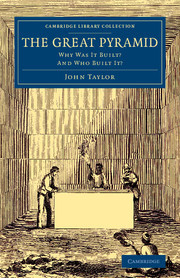The Great Pyramid Why Was It Built? And Who Built It? Cambridge Library Collection - Egyptology Series
Langue : Anglais
Auteur : Taylor John

In this 1859 work, John Taylor revealed the 'pyramid inch', though this alleged sacred unit of measurement was later debunked.
The publisher and author John Taylor (1781?1864), who took an interest in various antiquarian matters, published this work in 1859. Using the measurements taken by the seventeenth-century archaeologist John Greaves and by the French savants who had examined the Great Pyramid at Giza during Napoleon's Egyptian expedition, he deduced the existence of a 'pyramid inch' (fractionally longer than the British inch), which was one twenty-fifth of the so-called 'sacred cubit' and was derived from ancient astronomical and time-measurement observations; and as a convinced Christian, he concluded that the British inch was therefore divinely inspired. His work was very influential and had a considerable following (the astronomer Charles Piazzi Smyth's 1864 book on Our Inheritance in the Great Pyramid is also reissued in this series), but was later debunked by the more accurate surveys and measurements of Flinders Petrie, whose interest in Egypt was partly aroused by reading this book.
Part I. Exterior of the Great Pyramid: 1. The pyramids of Gizeh; 2. Earliest measures of the base of the pyramid; 3. Various heights ascribed to the great pyramid; 4. Various estimates of the Greek foot; 5. The measure of the great pyramid according to Herodotus; 6. The cubit of Karnak; 7. The royal or Philetaerian foot; 8. The sacred cubit of the Jews; 9. Degrees, minutes, and seconds in the table of constants; 10. Diameter of the earth; Part II. Interior of the Great Pyramid: 11. General description of the interior of the great pyramid; 12. The king's chamber; 13. The pyramid coffer the standard of all measures; 14. The pyramid coffer the measure of the laver; 15. The pyramid coffer the standard of Grecian measures; 16. The pyramid coffer the standard of English measures; 17. English weights derived from English measures of capacity; 18. Grecian weights derived from Grecian measures of capacity; 19. English and French systems of metrology compared; 20. Etymological illustrations; Part III. The Founders of the Great Pyramid: 21. Introductory remarks; 22. The founders not the race of Ham; 23. These shepherds were an abomination to the Egyptians; 24. The founders of the great pyramid were the race of Shem; 25. Noah the probable originator of the work; 26. The earth divided in the days of Peleg; 27. The canal of Joseph; 28. The builders of the tower of Babel were of the race of Ham; 29. The great pyramid alluded to in the Book of Job; 30. The great pyramid alluded to in the Book of Psalms; 31. Origin of the Arabian language; 32. Arabian numerals preceded alphabetic writing; Appendix.
Date de parution : 08-2014
Ouvrage de 340 p.
14x21.6 cm
© 2024 LAVOISIER S.A.S.



